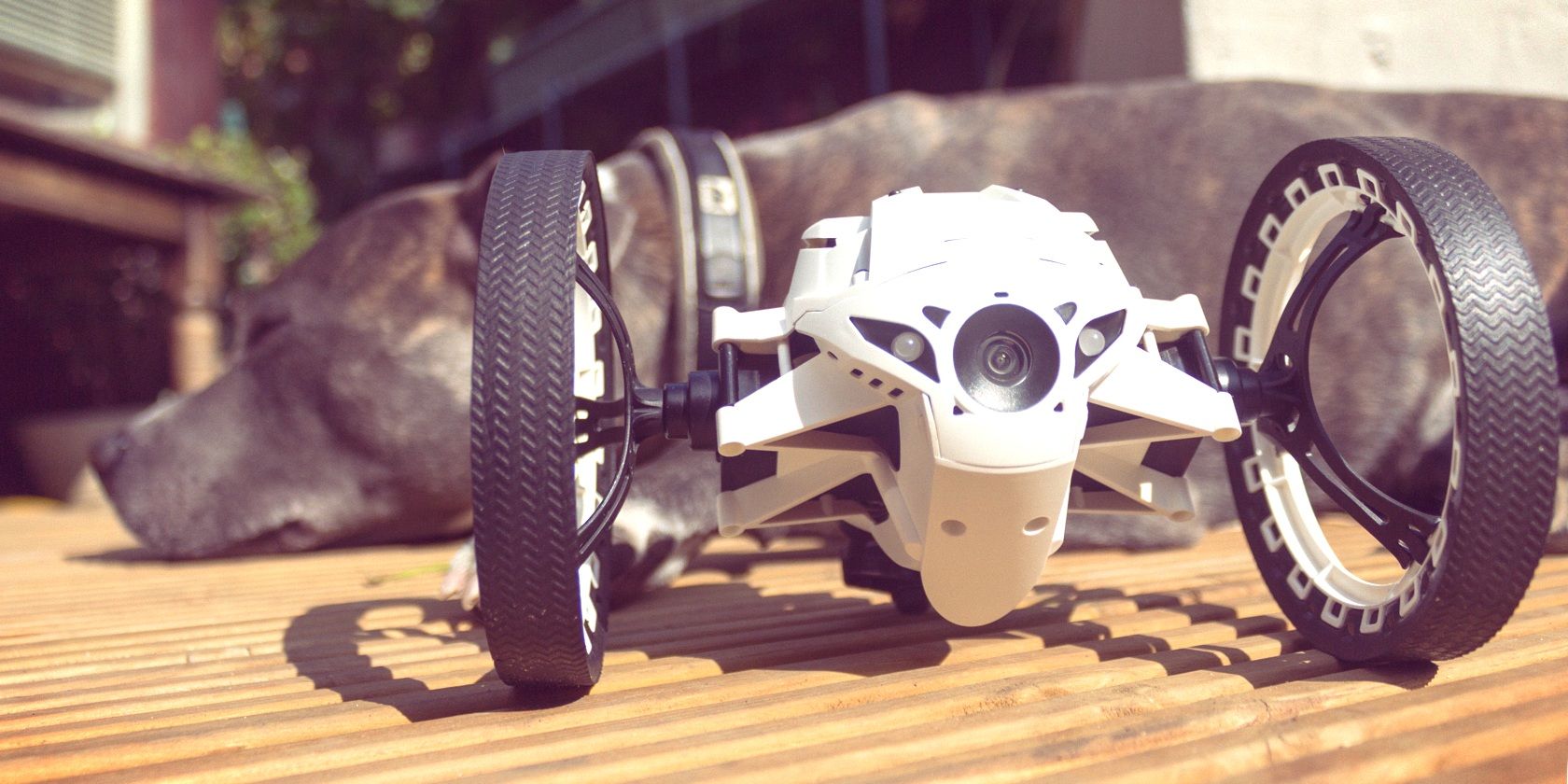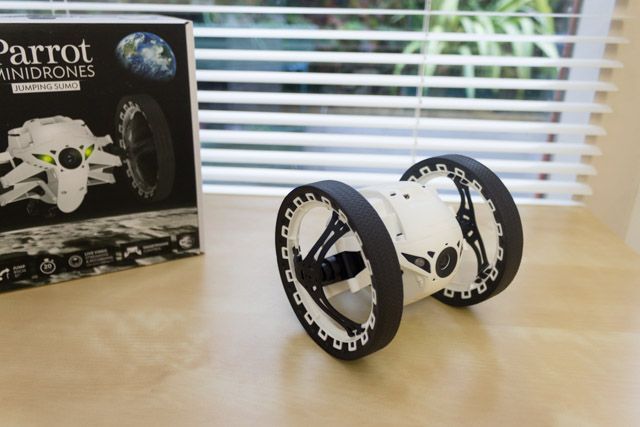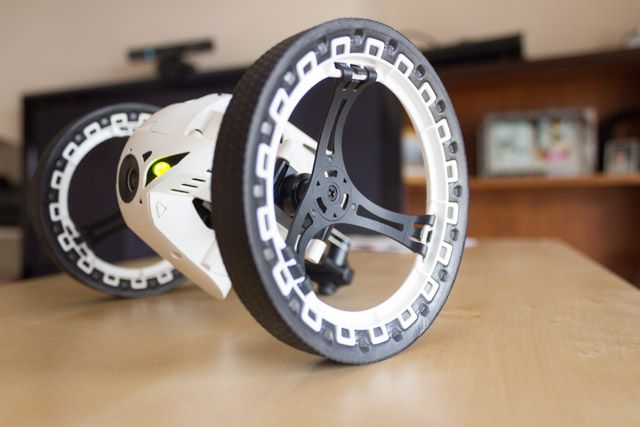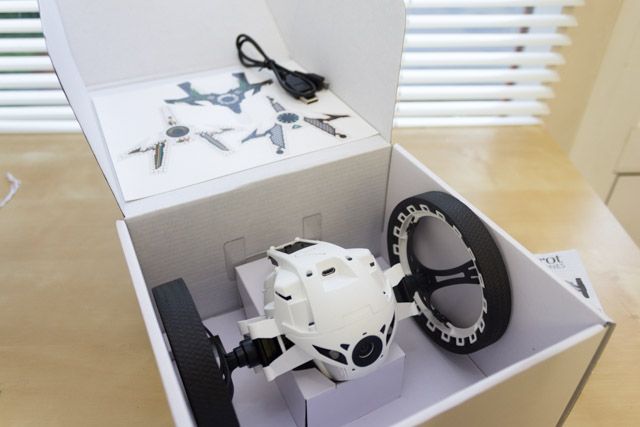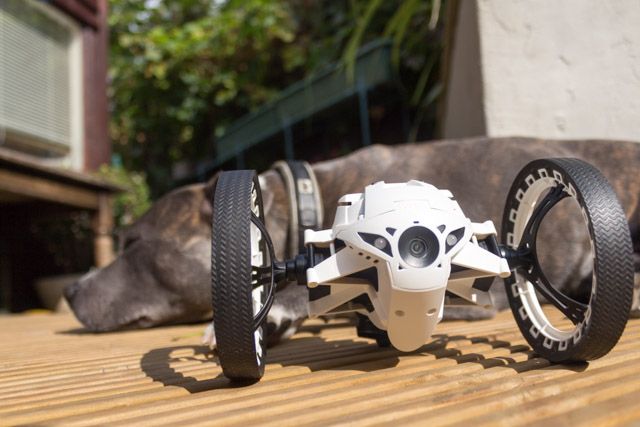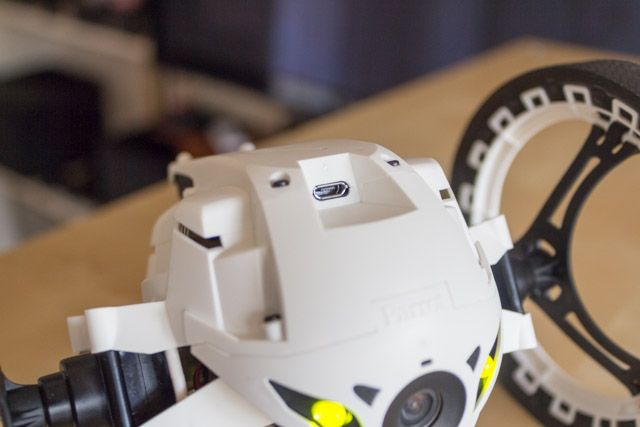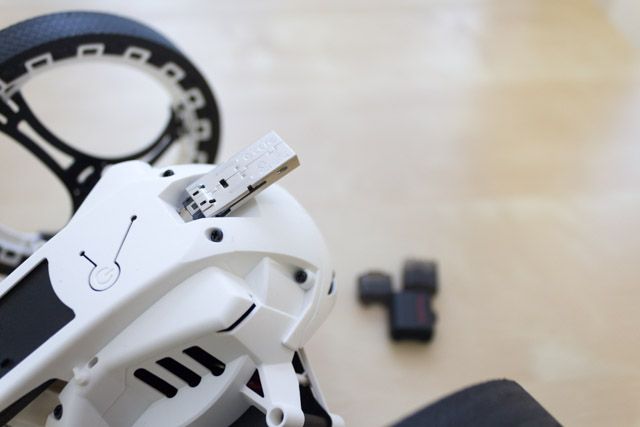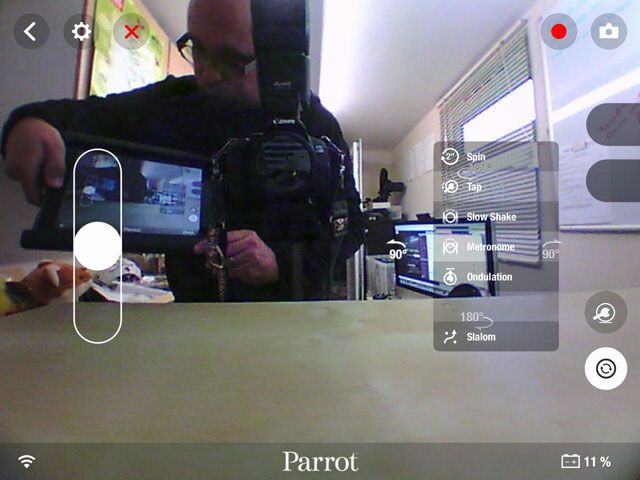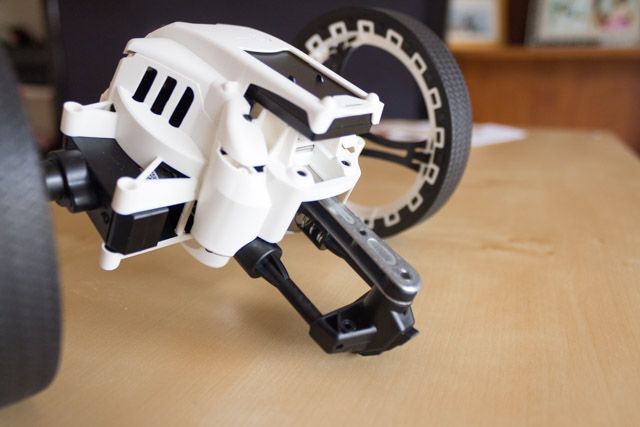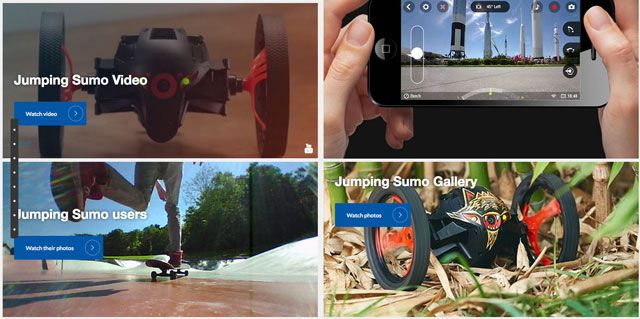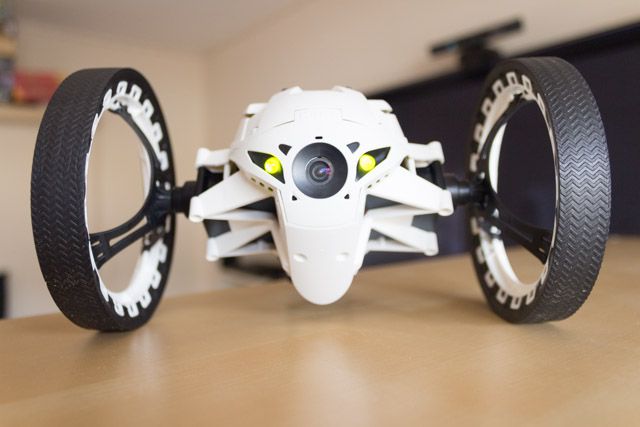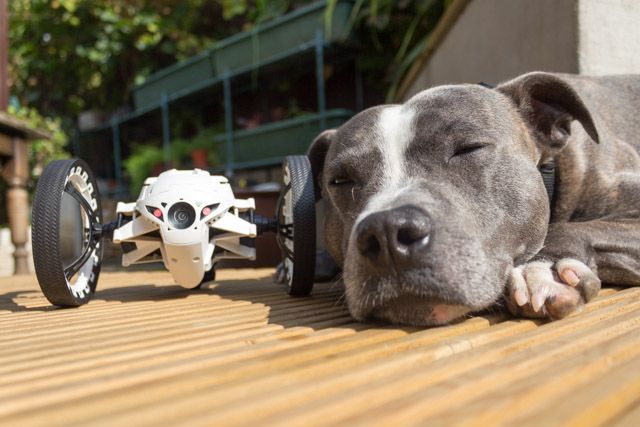Parrot Jumping Sumo Mini-Drone
Don't buy it. Overpriced toy that promises so much and delivers so little.
The first company to offer a truly consumer-level drone (which we reviewed a few years ago), Parrot has now introduced a range of more toy-like devices at a cheaper price point. Today, we take a look at the Jumping Sumo, a $160 Wi-Fi-controlled self-balancing two-wheeled drone with a wide-angle camera.
The Jumping Sumo does appear to be a first of its kind, but I do feel it needs to compete against cheaper toys such as the Hubsan X4, a $65 quadrocopter with HD camera; or this $80 spy tank.
Design
The first thing that struck me about the Jumping Sumo is how small it is - the main body fits in the palm of your hand, with the wheel diameter roughly the same. It's no more than 20 centimeters in width when the wheels are fully pushed out (more on that later).
The tyres are made of extremely lightweight expanded foam - they don't strike me as being particularly durable. There's a good selection of spare parts available from Parrot, including complete chassis, wheels, spring mechanisms and more, but I do feel that you should be getting something a bit more durable for the price (not to imply that it broke during testing, because it didn't, but it felt flimsy).
Also in the box are a set of 3 different stickers to personalise the face of your Sumo. I haven't applied any them though - what you see in the pictures is the bare white model. Black and brown models are also available, each with 3 different stickers.
Setup and Configuration
The Jumping Sumo broadcasts it's own wireless network; once fully charged and switched on, you can connect to the network from your smartphone or tablet, and launch the FreeFlight 3 application for Android or iOS. That's it: your drone is automatically detected and you can begin playing.
In theory, at least. The first time I tried playing with it indoors, it worked perfectly. Then I had no end of connection issues - after briefly staying connected for a few seconds, it would randomly disconnect. The Sumo can operate on either 2.4GHz or 5GHz WiFi, switched by holding down the on/off button for a few seconds. When it did eventually work, the video feed would cut out about at about 10m away, presumably due to the tiny wireless network being broadcast from the Sumo itself, rather than piggybacking on any existing network you've diligently pushed around the house. It would be nice to have the option of either using it's own network when outdoor, or an existing WiFi network for hassle-free indoor connection.
I assumed that the connection problems I experienced indoors were due to a variety of existing routers and wireless phone handsets, transmitting on both 2.4Ghz and 5Ghz bandwidth - but then I tried again outdoors, in a location with literally zero other networks. For 15 minutes, I persevered, experiencing the same connection issues - even after restarting my iPad and iPhone, disabling cellular data, restarting the Sumo. Then I gave up, went for a walk, and tried again - and suddenly it was all fine again. This is not the kind of frustrating experience you want from a high end toy.
Video Capture
Unlike the original Parrot flying drone that we reviewed last year, the Jumping Sumo is unable to record video streaming from the device - if you want to record video, you need to add a USB key through a micro-USB connection port.
Good luck hunting one down, because most "micro" USB sticks simply mean "quite small", and don't in fact refer to the port connection provided. I could only find one available on the market from Sandisk, and even that was too big to fit into the tiny recessed space on the Sumo, so I ended up ripping the case off. And of course, it bent out of shape after a few jumps.
Thankfully it's pretty easy to pull video off the device once it's all plugged in, assuming it didn't fall out during your adventures - but the quality leaves a lot to be desired. With only 640 x 480 pixels in a world where everything is HD, I would have expected better from something this expensive.
Furthermore, the USB key needs to be re-inserted each time - if left in between play sessions, it simply refuses to record and demands you (re)insert one.
Note that you can take decent photos on the Sumo and save them to the internal memory - just not videos.
Control Modes and Operation
Everything is controlled through the easy-to-use Freeflight 3 app. The only thing that I had to look up was how to get finer direction control, which is done using the tilt sensor of your device, but only when a finger is placed on the white spot you see on the left of the screen (this also controls forward and back). A selection of pre-programmed "tricks" can be found under one of the menus, while a helpful battery level indicator is shown in the bottom right.
Shockingly, this diminutive little beast jump a full 80cm, which I can assure you is quite terrifying to behold. A slow wind mechanism prepares the strong springs for release, so jumps must be primed in advance. You can do this by sliding the jump button to the left; sliding again will fire off the jump.
Although capable of jumping 80cm, you shouldn't allow it to fall that far. Falling from a maximum of 40cm is recommended, so you'll want to set up some boxes and chairs to get down from whatever it is you've climbed onto.
The Jumping Sumo in fact has 3 modes of operation. The first is a standard mode with the camera facing forward in which jumps are possible. The other two feel badly tacked on.
Of those, "kick" mode turns the Sumo over such that the spring release is facing slightly upwards, so it can now kick objects. The problem with this mode is that camera faces backwards, so you can't see what's going on remotely, and the controls remain fixed on the view of the camera - which means you have to back into something in order to kick it. It's just a bit silly, really, and rather unintuitive.
The third mode is "self balancing", designed to go over uneven terrain, but generally results in the Sumo throwing a fit of the wobblies. I should note that since it points the head downwards, you can't use a USB key in this mode -- not that you'd need to anyway I guess, since the camera is facing the floor, but I mean you'll actually need to remove one if you've already got it stuck in there.
Finally, we should mention the route planning feature of the software, in which you can choreograph the Sumo from all available actions. It opens up a new style of play, in which you can challenge yourself to complete an obstacle course or create a movie sequence (leaving you free to film the resulting actions).
Going Offroad
I was really looking forward to taking this bad boy outside and thundering through a forest or two, but that proved to be impossible. The Sumo (despite it's heavyweight name) is so light on the ground, coupled with zero tread slippery wheels, that it's just not able to get any traction - at all. Check out the video to see how it reacted on grass and a forest floor. It's even more disappointing when the product gallery on the Parrot website prominently features the Sumo sitting atop a bamboo grove.
If the ground is perfectly flat, you're able to get some traction, but it's still severely limiting. Let's be clear: this product was not designed for use outdoors, at all. It excels on shiny surfaces like laminate flooring and plastic.
Battery Life and Charging
Charging via a common standard micro-USB socket, a full charge takes approximately 1.5 hours, for which the battery will then provide 20 minutes of play time. Given this rather small battery, you'd be well advised to buy an additional spare battery, or at the very least take a portable charger with you if you'll be spending a long day out at the park. There's an indicator as to how much battery is left on your FreeFlight app display; at least, when it finally connects, there is.
It should also be noted that 20 minutes is optimistic - performing many jumps or tricks will reduce this significantly. As will sitting there reconnecting endlessly.
Should You Buy One?
In the UK, the price jumps to almost $250 thanks to VAT and import taxes. Even in the US though - add in the cost of a new battery, a memory stick to record video, and probably replacement parts after a short while, and the price will quickly add up. It's difficult to justify the costs, regardless of how fun this toy is - which it can be, when it works, indoors.
On paper at least, there's a lot going for this tiny robot. The practical application of those features however is lacklustre at best, and downright frustrating at worst - it fails on many levels. Overall, I'm just really disappointed. The original Parrot AR Drone felt like it could be used by anyone to capture stunning aerial videos of any environment; the Jumping Sumo mini-drone is limited to indoors, and ultimately becomes an expensive toy. Coupled with the endless connection issues, ridiculously short battery life, and difficulties in actually recording video, I'm afraid this one should be left on the shelf.
[recommend]MakeUseOf recommends: Don't buy it. Overpriced toy that promises so much and delivers so little.[/recommend]
How Do I Win The Parrot Jumping Sumo?
Parrot Jumping Sumo Mini-Drone
The winner will be selected at random and informed via email. View the list of winners here.
Send your products to be reviewed. Contact Jackson Chung for further details.

